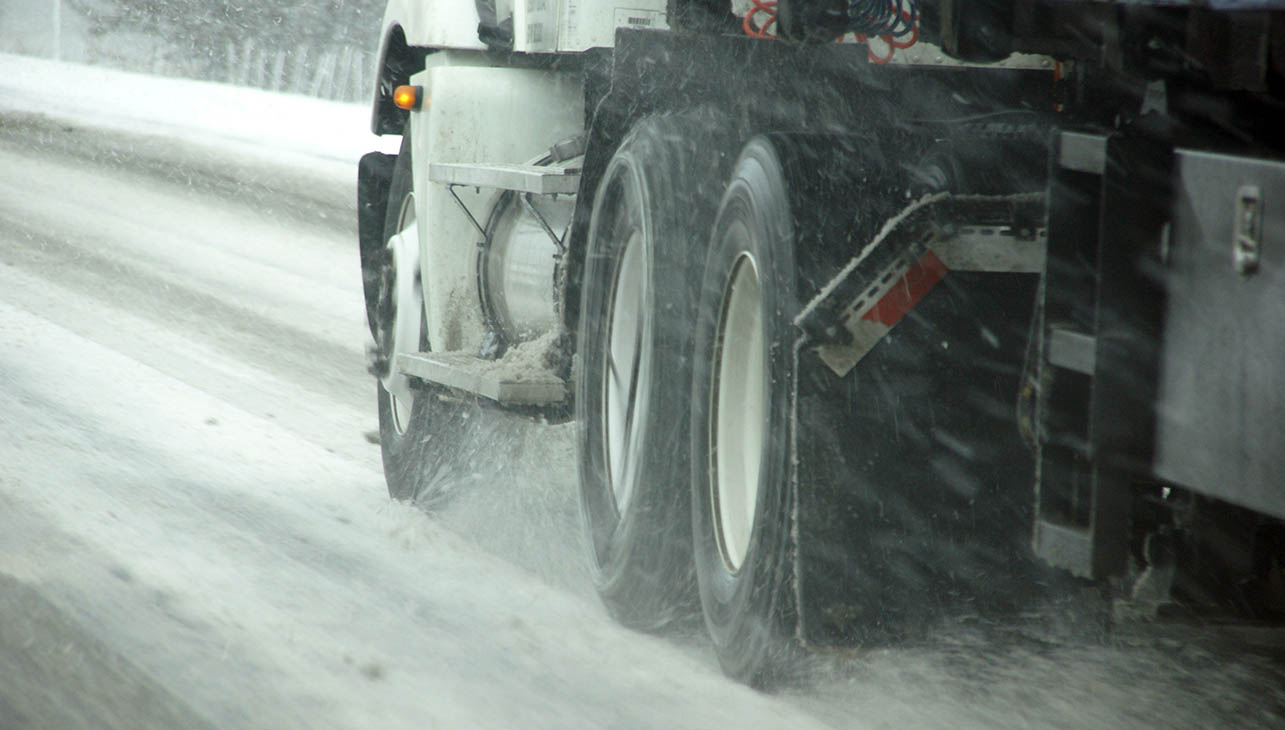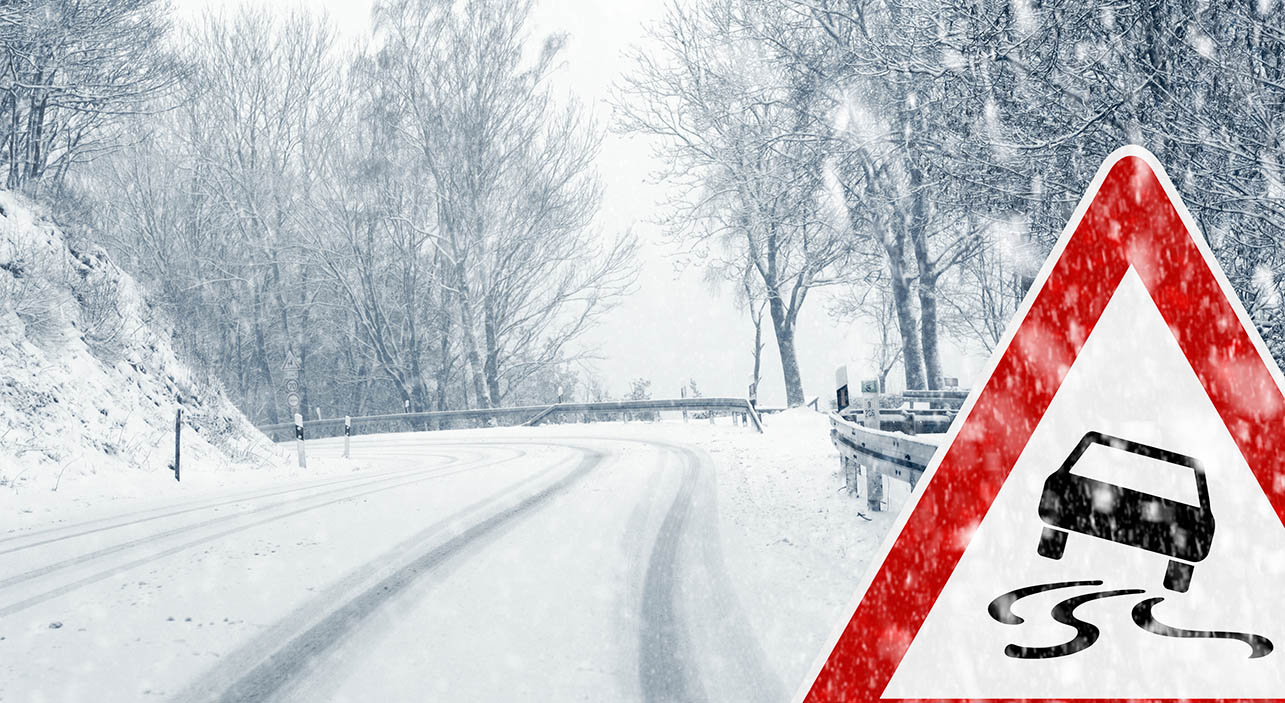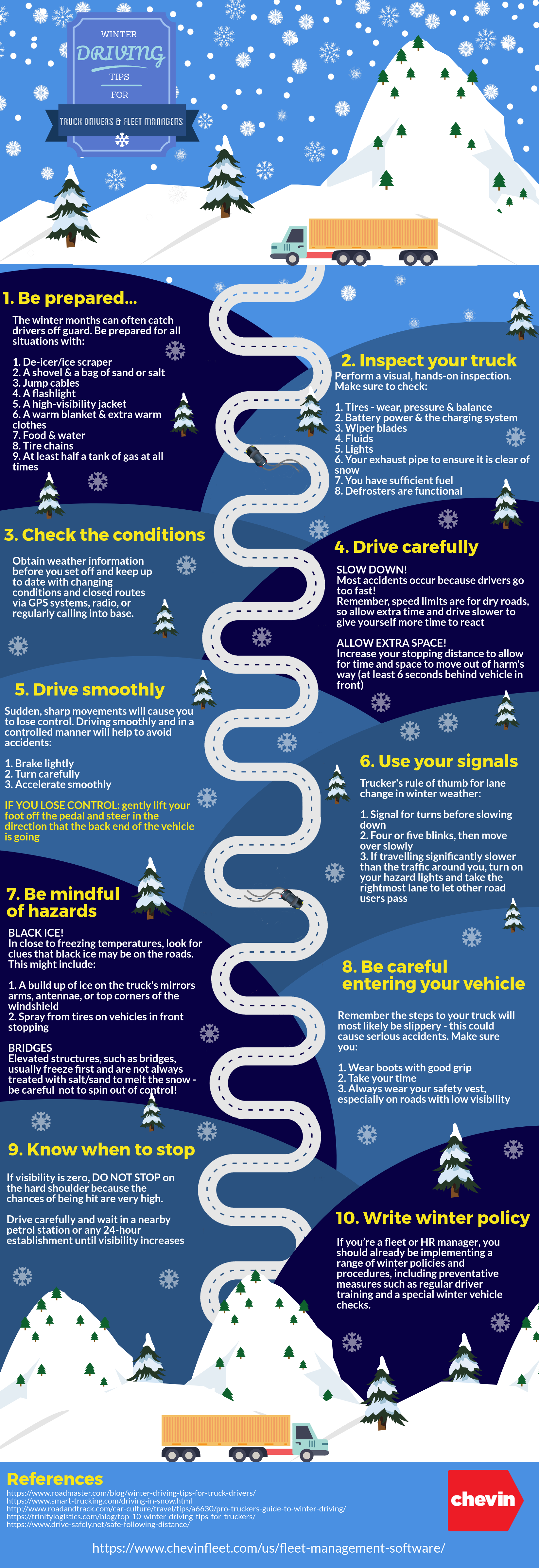Learning Zone
10 essential winter driving tips for truck drivers [infographic]
Trucking in winter can be extremely dangerous, and demands a specific set of skills to be able to safely reach your destination.

As we head into the midst of a gray and cold winter, it’s important to continue protecting fleet operations when driving in adverse weather conditions. Even when the holiday season is over, the short, cold days will continue.
To help you stay safe on the roads this winter, we have produced an infographic with 10 trucking safety tips:
1. Be prepared for every situation
It’s important to check that you have the right equipment before you start your journey, especially during the harsh winter months. Make sure you are ready for every possible situation and be sure to check that you have the following items to hand:
❄ De-icer and ice scraper – front and rear windscreens must be clear of snow and ice before you set off
❄ A shovel and a bag of sand or salt – minor roads don’t tend to be gritted and it’s quite easy to get stuck
❄ Jump cables -just in case your truck (or someone else’s) won’t start
❄ A flashlight
❄ A high-visibility jacket
❄ A warm blanket, and extra warm clothes – it’s always worth carrying extra clothes in case you get stranded
❄ Food and water – just in case you get stuck and are awaiting recovery or help up in heavy traffic
❄ At least half a tank of gas always – journeys make take longer than planned or you may need to find alternative routes
2. Inspect your truck
When it comes to vehicle inspections, you may need to slightly alter your regular checks during winter months.
Importantly, you should check your:
❄ Tires – wear, pressure and balance
❄ Battery – power and charging system
❄ Wiper blades – working and free from snow and ice
❄ Fluid levels – topped up
❄ Lights – fully functional
❄ Exhaust pipe – ensure it’s clear of snow
❄ Defrosters – ensure they are functional
Carrying out daily paper-based walk-round checks on paper can be a lot harder when it’s cold. Consider sapping to an digital forms app. this removes the risks of wet or damaged paperwork, illegible handwriting and the need for administrative support to input the information into a system.
3. Check the conditions
Keep up-to-date with weather information before you set off and remain aware of changing conditions and closed routes via GPS systems, radio or be regularly calling into base. This is where telematics can be a great help in knowing where drivers are, the routes that they are taking and the opportunities to find alternative, safer routes.
4. Drive carefully
Sudden, sharp movements can cause you to lose control – hard acceleration and braking decreases traction. Keep to a steady, consistent speed and go easy on the brakes. hold the distance between you and the vehicle in front to retain a comfortable braking distance in icy conditions. With over 17% of all vehicle crashes occur during the winter months, drivers should:
❄ Slow down
Most accidents occur because drivers are travelling too fast. This is especially dangerous for truck drivers as it takes much longer to bring the vehicle to a halt if there is an obstruction or incident in the road ahead. When getting behind the wheel of an unfamiliar vehicle, take the time to become accustomed to how the vehicle handles and be award that it’s much harder to control or stop on a road that is covered in snow! Remember that the speed signs are intended for dry roads and good weather conditions!
❄ Allow extra space
Increase your stopping distance to allow time to react to the vehicles in front of you in bad weather or poor road conditions. In such conditions allow ten times the normal stopping distance. Remember, trucks need more time to stop than cars do.

While there’s often a tendency to associate hazardous weather mainly with snow and ice, fog, rain and sun dazzle can all have a huge impact on driver safety too.
5. Drive smoothly
Sudden, sharp movements can cause you to lose control and similarly, hard acceleration and braking also decrease traction. Hold a consistent, steady speed and be easy on the brakes – keeping a good distance between you and the car in front, you will always have a comfortable braking distance in icy conditions.

6. Use your turn signals
Trucker’s have a rule of thumb when changing lane; for every road condition.
For winter trucking, use four or five blinks and then move over slowly into the next lane. Don’t feel the need to match the speed of the drivers around you. If you’re cautious of your truck on the winter roads, hold your speed and use your hazard lights – this tells other road users that you are going slower than they are.
7. Be mindful of hazards
Trucking in winter can be seen as a hazard in itself, but there are two particular hazards you should watch out for:
Black ice
In close to freezing temperatures, look out for clues that black ice may be on the roads. Black ice is a dangerous road condition, and presents itself as a thin layer of transparent ice that often makes the road look slightly wet. Signs that you’re at risk from black ice include:
❄ A build-up of ice on your trucks mirror arms, antennae or the top corners of the windshield
❄ Spray from tires on the vehicles in front of you – if this spray stops, be aware of the possibility of black ice
Fog
In heavy, thick fog that limits visibility, use your lights and slow down. Even if vehicles are travelling faster that you are comfortable with. Use your wipers and demisters to keep windscreens as clear as possible.
Heavy rain
If you’re struggling to see the road ahead due to heavy rain, then it’s advisable to slow down. Keep a good distance between you and the vehicles in front and beware of aquaplaning when tyres lose traction due to water on the road. If your vehicle does start aquaplaning, hold the steering wheel straight, gently ease off the gas and avoid hitting the brakes until you regain control.
Bridges
Elevated structures, such as bridges, usually freeze first and are not always treated with salt/sand to melt the snow or ice. During the winter months, be sure to approach these areas carefully, to avoid spinning out or losing control.

8. Be careful when entering and leaving your truck
This may seem like an obvious point, but it’s common for truck drivers to fall and injure themselves by underestimating just how slippery their vehicle’s steps are.
Take your time and wear boots with a good grip to reduce your chance of slipping and injury. Also, when visibility is low, always remember your high-visibility vest!
9. Know when to stop
There’s a good time and a bad time to stop driving. When winter conditions become so treacherous that driving no longer becomes possible, find a place to stop. wherever possible, do not stop on the hard shoulder as this will dramatically increase your chances of being hit. Instead, drive carefully to a gas station or any 24-hour establishment and wait until visibility increases.
10. Driver Training & Awareness
To help reduce winter driving risks, you should already be implementing a range of preventative measures – such as regular driver training in order to create a team of better drivers, and frequent maintenance checks – but it’s also important to have a solid process for managing related KPI’s.
For example, it’s all very well specifying regular vehicle checks, but how do you ensure these are completed fully and on-time?
The first step is always to gain awareness of what’s going on in your operation. Start by asking measurable questions such as: “to what extent are drivers trained for harsh driving conditions?” and “are any drivers or vehicles more at-risk?” or “is a winter driving policy available – and who has read it?” and “how is daily vehicle roadworthiness ensured?”
Gaining answers to these questions isn’t as hard as you may think. For example, software such as telematics can be a goldmine of information, if you know how to use the data generated. You could integrate your telematics system with your driver management software to run reports on behavior, and identify individuals that could benefit from enhanced training.
Driver management software can also be configured to automatically send reminders and alerts for new starters, drivers who display risky behaviors, those who are due for refresher training, or even scheduled drug and alcohol testing.
Although bad weather is out of your control, it’s possible to be more organized to reduce both risks and possible accidents occurring in your fleet this winter.




